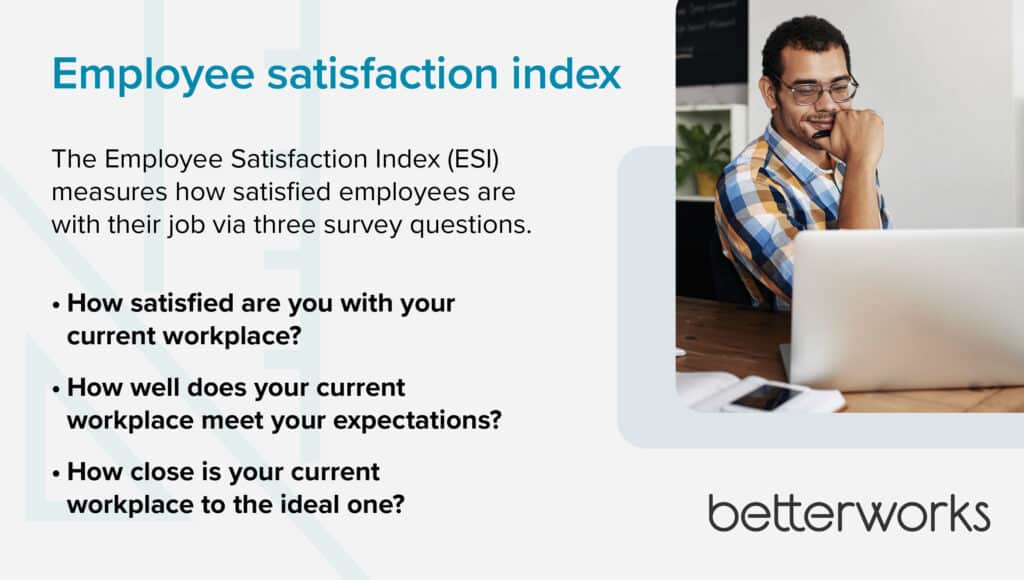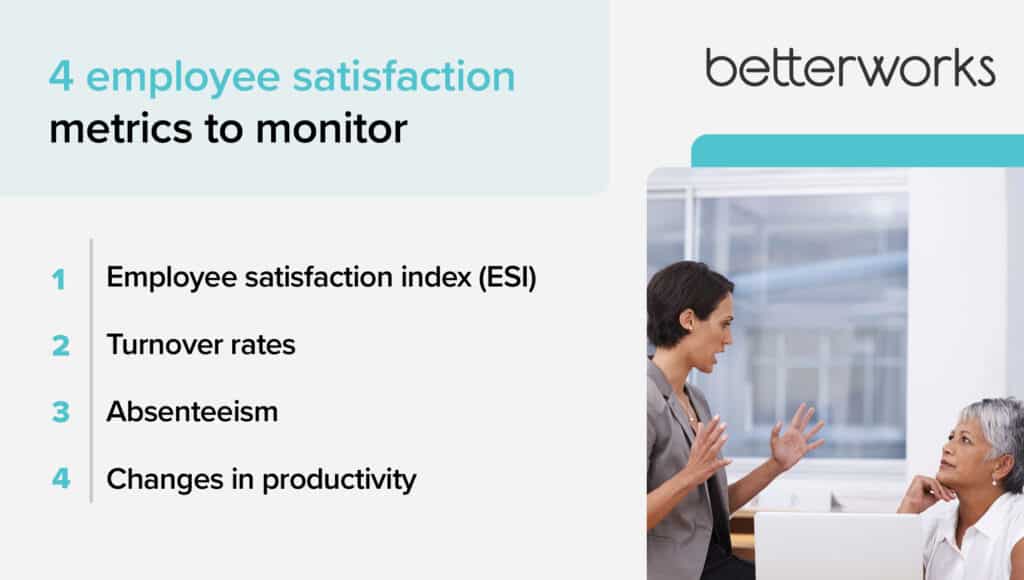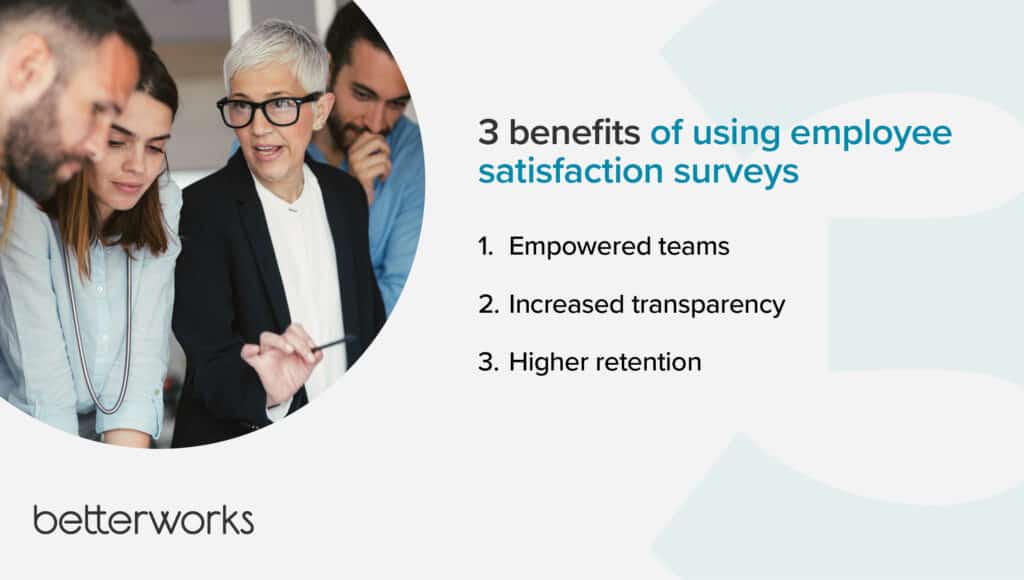- Why is employee satisfaction important?
- What is an employee satisfaction survey?
- Why should you implement employee satisfaction surveys?
- What can you measure in an employee satisfaction survey?
- 4 common employee satisfaction metrics
- 3 benefits of employee satisfaction surveys
- What do you do with survey results?
- Employee satisfaction survey template
- Satisfied employees create a better workplace
Surveying your employees is a great way to monitor your company’s culture and identify issues before they cause widespread issues. But to be effective, you need to use an employee satisfaction survey template that fits your organization’s needs.
This is especially important now, since research shows that employees are less satisfied today than they used to be. According to MetLife’s 20th annual U.S. Employee Benefit Trends Study, only 66% of employees are satisfied with their job — a 20-year low. Job satisfaction is particularly low among women, Generation Z, people of color, and manual laborers. And 53% of the youngest workers (those born from 1993-98) say that an unfulfilling job is a top source of stress.
This problem didn’t start during the pandemic, and it’s not limited to longtime workers — employees can become dissatisfied at work as early as age 25.
Explore why employee satisfaction is so important, how employee satisfaction surveys can benefit your organization, and how to create them.
Why is employee satisfaction important?
Satisfied employees are positive, productive, and aligned with your company’s goals and objectives. By making sure employees feel satisfied, organizations increase retention, reduce absenteeism, and improve performance.
Employee satisfaction and engagement are two terms often used interchangeably, but they are not the same.
- Employee satisfaction: How content employees are with their jobs and the conditions within the work environment.
- Employee engagement: How employees feel about their emotional connection to and passion for the work, and whether they derive meaning and purpose from it.
Elements of employee satisfaction include whether people feel respected, praised, and recognized, whether they receive fair compensation, whether they’re motivated, and their level of fulfillment at work.
Creating a culture and environment that employees are happy to return to each day is an essential component of your talent strategy.
What is an employee satisfaction survey?
Employee engagement surveys are common now in large organizations. Your employee satisfaction surveys can run concurrently with them to collect data on employee satisfaction metrics and experiences.
Employee satisfaction surveys empower you to gather feedback about the organization directly from employees. Surveys enable employees to anonymously express their opinions about the workplace, which increases their likelihood of being honest and removes fears about retaliation.
Employee satisfaction surveys can address a variety of factors, including how employees feel about their experiences at work, the company culture, and the quality of workplace communication.
Why should you implement employee satisfaction surveys?
Surveys can help you distinguish between isolated incidents of dissatisfaction and widespread concerns across your workforce. Employee satisfaction surveys don’t replace conversations between managers and their direct reports. They provide an additional line of communication between employees and company leaders, one with a more global perspective.
For example, how many employees at your company feel unfulfilled by their jobs? If so, why do they feel that way? What can be improved to fix the problem?
Employee satisfaction surveys can provide leaders with broad insights into morale and inform the specific actions that can be taken to improve employee satisfaction and retention at scale.
Those actions can then be coupled with other data to predict retention rates and other workforce indicators.
What can you measure in an employee satisfaction survey?
Employee satisfaction surveys enable you to measure a variety of factors related to workforce satisfaction.
- Working conditions. Do employees understand what’s expected of them in their roles, and do they have the resources they need to meet their goals?
- Compensation and benefits. Do employees feel they’re being fairly compensated for the work they’re putting in?
- Workplace culture. Do your employees feel like the organization is living out its stated values around diversity and inclusion, for example?
These types of questions can help you determine which practices are driving satisfaction and where you might be weaker.
4 common employee satisfaction metrics
What metrics do you need to track to evaluate your organization’s employee satisfaction?
Employee satisfaction index
The Employee Satisfaction Index (ESI) measures how satisfied employees are with their job via three survey questions. These questions can also be asked as part of a longer survey.
- How satisfied are you with your current workplace?
- How well does your current workplace meet your expectations?
- How close is your current workplace to the ideal one?
Employees answer each question on a scale of 1 to 10, with 10 being the top rating. ESI is calculated with the following formula:
ESI= [((question mean value ÷ 3) – 1) ÷9]*100
Your company’s ESI can be used as a benchmark for internal progress or against other companies. The higher your results are, the more satisfied your workforce is. As you implement calculated changes over time, you can use the results of a regular ESI to determine which changes had the greatest impact on improving employee satisfaction.

Turnover
Employees who aren’t content in their current situation are more likely to consider departing for jobs that will supply their ideal workplace conditions.
A 2022 FlexJobs survey found that 62% of people who quit their jobs did so because of the culture. Other leading reasons included burnout and a lack of flexibility or remote work options.
Similarly, employees who feel they have no autonomy over when and where they work are unlikely to say they’re satisfied.
All of these factors relate to employee satisfaction and can be teased out through surveys. For example, when people feel burned out, they are less likely to say they’re satisfied on a survey. They might also say they feel overwhelmed, exhausted, or unmotivated, which can signal burnout and a higher risk of turnover.
Absenteeism
When employees aren’t satisfied with their work, they may not tell you so directly. They may express their unhappiness through frequent callouts. If you’re seeing this as a widespread issue in your organization, you may have an employee satisfaction problem.
However, keep in mind that absenteeism by itself isn’t necessarily a signal of low employee satisfaction, particularly at the individual level. Employees are absent for all sorts of unavoidable or scheduled reasons, including medical conditions, vacation, and long-term leave.
Focus your attention on unaccounted-for absences, and look for correlations with other signs of dissatisfaction in your workforce.
Changes in Productivity
Happy employees are more likely to be productive. A 2019 study at a British telecommunications firm found that productivity improved by 13% among telesales workers when they reported being happy. The study found that happiness at work correlated with a higher rate of calls that converted to sales.
Other studies have also correlated high employee satisfaction with higher productivity. While performance metrics such as efficiency and work quantity also influence productivity, happiness is a likely factor in the productivity of many employees across many job roles and industries.
Compare the results of your employee satisfaction survey with workforce productivity metrics to begin assessing the correlation between the two in your organization.

3 benefits of employee satisfaction surveys
Regular employee satisfaction surveys lead to a number of positive impacts on the business.
Empowered team members
Employee satisfaction surveys empower your teams by giving them a voice. These surveys, especially when conducted regularly, allow your team members to express their opinions anonymously without worrying about retaliation.
Regular surveys also help managers do their job better. By becoming aware of issues that harm job satisfaction, managers can address them immediately or bring these issues up in team meetings and one-on-one conversations as appropriate. This type of survey feedback can also prompt managers to examine their leadership and how they can better apply their skills to workplace situations differently.
Increased transparency
The 2022 Future Forum’s Pulse Summer Snapshot report found that employees who perceive their companies to be transparent have 12 times greater job satisfaction than employees who have the opposite perception.
Employee satisfaction surveys improve transparency because they show how the company is interested in working conditions and what workers are experiencing. That benefit, however, depends on leadership sharing the overall results of these surveys and demonstrating how they’ll address shortcomings.
Higher retention
Part of feeling satisfied at work is feeling that you’re appreciated and heard, and employees who don’t feel that way are quick to seek other jobs.
In fact, 57% of people who quit jobs in 2021 cited a lack of respect at work, according to a Pew Research survey. That survey also cited other factors in quitting that suggest low job satisfaction, including low pay, poor advancement potential, and a lack of flexibility.
By using surveys as a tool to identify and address issues before they escalate, leaders can retain employees by solving for the issues that would otherwise drive them away.

What do you do with survey results?
Employee satisfaction surveys produce raw data. The value comes from interpreting what the data says about your workforce.
Survey software can not only send surveys but also collect the results and help HR teams understand what they mean. Once you can pinpoint the root causes of dissatisfaction, you can take action to overcome them.
After analyzing the data, make a plan for addressing the problems you’ve uncovered. But don’t stop there: share your intentions with employees and take care to follow through on your promises. The success of your employee survey program hinges on communication and trust. Let workers know that you hear them and what you’re doing in response to their feedback.
Employee satisfaction survey template
There are many types of employee satisfaction surveys, including pulse surveys, which consist of a few targeted questions that you deliver frequently throughout the year. Survey length generally depends on how many times per year you’re canvassing employees. An effective employee satisfaction survey template addresses these elements.
Survey structure
What kind of survey experience are you seeking to offer?
If your survey intends to calculate your organization’s employee satisfaction index (ESI), you will need to use a 1-10 ranking system where 1 is worst and 10 is best. Surveys can apply this answer range to all questions, along with space for open-ended responses either as part of individual questions or at the end of the survey.
Another option is a hybrid survey, with some questions answered using a rating system and others requiring multiple-choice selection, true-false answers, or open-ended responses. These options can give employees more freedom to provide qualitative responses.
Whatever structure you choose, remember that your employees should be able to fill out your survey in just a few minutes, and your instructions should be clear.
Survey questions
The questions you choose to include depend on the survey’s purpose and the data points you want to collect. For example, an annual survey might consist of a range of questions attempting to gauge the overall employee experience, whereas a pulse survey might focus on a specific topic.
Questions tend to fall under several main categories, including communication, leadership, engagement, career development, inclusion, performance, and alignment. Some sample questions and statements in these categories might include:
- When the organization makes changes, do you understand why? (Alignment)
- Do you feel there are opportunities for career growth at this organization? (Career Development)
- How often do the tasks assigned to you by your immediate supervisor help you grow professionally? (Career Development)
- Do you usually know whom to ask for help when uncertainty arises? (Communication)
- I feel that I can talk to my direct manager about problems honestly and openly. (Communication/Leadership)
- How meaningful is your work? (Engagement)
- Do you believe our company celebrates diverse ideas and people? (Inclusion)
- Do executives contribute to a positive work culture? (Leadership)
- I receive valuable feedback from my direct manager regularly. (Leadership)
- Do you feel recognized for your diligence and successes at work? (Performance)
Survey writers can become stuck because they have too many questions to choose from. Narrow your choices by asking yourself:
- Does this question tell us something useful or something interesting?
- Does this question overlap with or repeat another question in the survey?
- Is this question relevant to everyone in the organization?
- Are we prepared to take action or make changes based on responses to this question?
Employee survey software often includes a bank of sample questions that you can draw from and customize to meet the needs of your unique organization.
Satisfied employees create a better workplace
Remember that employee satisfaction surveys should help employees express their viewpoints and assist your HR team in assessing organizational health. Use these surveys as a tool to improve communication and employee retention while giving you a better understanding of the factors that bring your workers happiness.
Set a cadence for issuing these surveys and regular tasks for your team to create the surveys, analyze the results, make recommendations, and consider the next round of questions. Using a template can make the survey process easier, more repeatable, and easier to compare data against past results, especially if you commit to monthly or quarterly surveys.
When you know why you want to measure job satisfaction and you have the right employee satisfaction survey template, you can improve employee happiness to drive productivity, retention, and better business outcomes.
Explore what to do with employee survey results: a seven-step process for HR.


